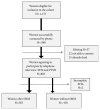Quality of Life after an Episode of Severe Maternal Morbidity: Evidence from a Cohort Study in Brazil
- PMID: 30105265
- PMCID: PMC6076926
- DOI: 10.1155/2018/9348647
Quality of Life after an Episode of Severe Maternal Morbidity: Evidence from a Cohort Study in Brazil
Abstract
Objective: To assess quality of life (QOL) in women who experienced a severe maternal morbidity (SMM) event and associated factors, in comparison to those who did not.
Study design: Retrospective cohort study performed at the maternity of the University of Campinas in Brazil, including 801 women with or without SMM, within 6 months to 5 years after delivery. Women were interviewed by phone and data were electronically stored, using the Brazilian version of the SF36 to assess women's self-perception of quality of life. To analyze a possible relationship between SMM and perceived impairment in quality of life, χ2 and Fisher's Exact tests were used. Multiple analysis using Generalized Linear Models was applied to identify factors independently associated with the general health score. The main outcome measures were general and domain-specific SF36 scores on quality of life.
Results: Maternal morbidity conditions were associated with lower scores of patient perceptions of quality of life in the following domains: physical functioning, role-limiting physical, pain, and general health status. A lower level of school education, not having a partner, caesarean section, and history of previous clinical conditions were associated with a worse perception of general health and quality of life.
Conclusion: Health professionals should know the association between life conditions, previous chronic health conditions, and SMM for women during prenatal care to beyond 42 weeks postpartum. Longitudinal and interdisciplinary actions should be put into practice to provide healthcare for these women, with special emphasis on the effective reduction in health inequities.
References
-
- Pacagnella R. C., Cecatti J. G., Camargo R. P., et al. Rationale for a Long-term Evaluation of the Consequences of Potentially Life-threatening Maternal Conditions and Maternal "Near-miss" Incidents Using a Multidimensional Approach. Journal of Obstetrics and Gynaecology Canada. 2010;32(8):730–738. doi: 10.1016/S1701-2163(16)34612-6. - DOI - PubMed
MeSH terms
LinkOut - more resources
Full Text Sources
Other Literature Sources
Medical


